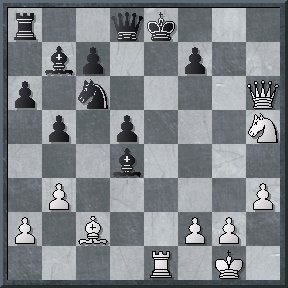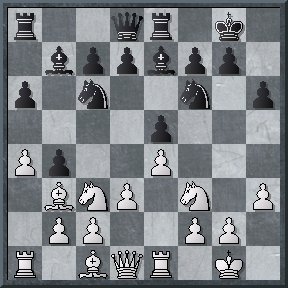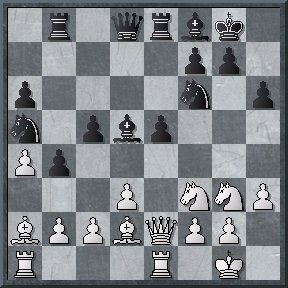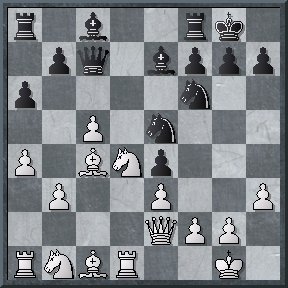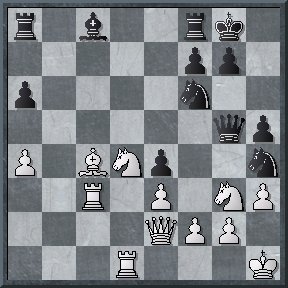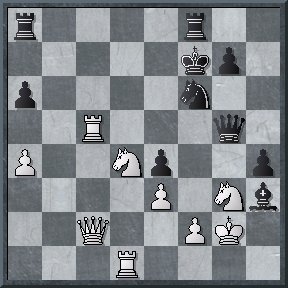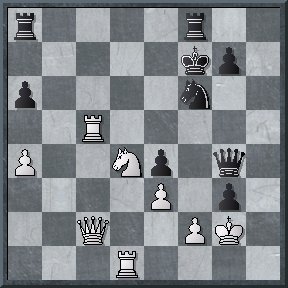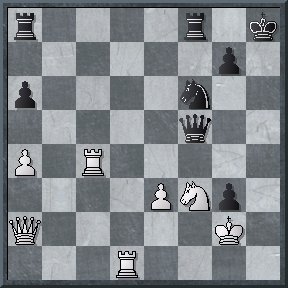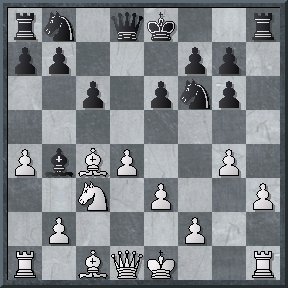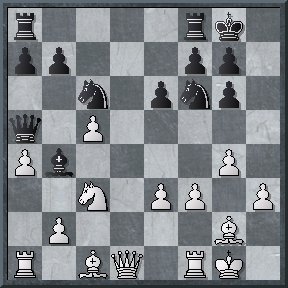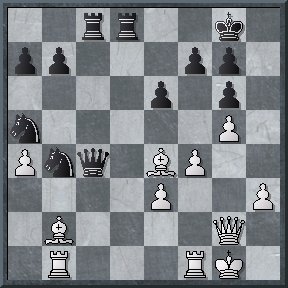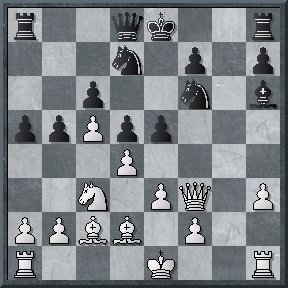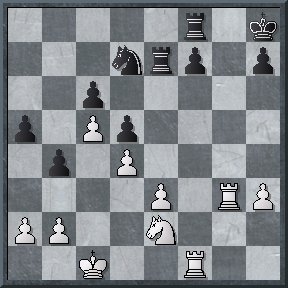07.11.2006
TAL MEMORIAL. GAMES OF ROUND 1 COMMENTED
Tal memorial - a supertournament currently taking place in Moscow - has collected among its participants mostly ambitious and highly motivated to fight players. The fact cannot but make the spectator glad. And already the first round was marked with 3 games out of 5 finishing not peacefully. For such a level it`s a real bloodshed.
Let`s begin with the two draws. By the way, they are quite depressive.
Shirov,A (2720) - Mamedyarov,S (2728) [C95]
Tal Memorial Moscow RUS (1), 06.11.2006
[VVY]
1.e4 e5 2.¤f3 ¤c6 3.Ґb5 a6 4.Ґa4 ¤f6 5.0-0 Ґe7 6.¦e1 b5 7.Ґb3 d6 8.c3 0-0 9.h3 ¤b8 10.d4 ¤bd7 11.¤bd2 Ґb7 12.Ґc2 ¦e8 13.¤f1 Ґf8 14.¤g3 g6 15.b3 d5 16.Ґg5 h6 17.Ґh4 g5 18.¤xg5 hxg5 19.Ґxg5 exd4 20.e5 ¦xe5 21.¦xe5 ¤xe5 22.cxd4 ¤c6 23.¤h5 Ґe7 24.Ґxf6 Ґxf6 25.Јd3 ўf8 26.Јh7 Ґxd4 27.Јh6+ ўe8 28.¦e1+
"The tense interesting struggle in materially unbalanced position" up to this moment is an illusion. All this is the theory. Previously played 28...¤e7 29.Јg5 (29.Ґf5 Ґc8[] 30.Јc6+ ўf8 31.Јh6+=) 29...ўf8[] 30.Ґh7 led in a game Landa-Kosyrev to a position where the evaluation is probably draw but the opponents tasks differ too much, white looking for any means to increase the threats and black being doomed to only moves to maintain the evaluation. Thus here comes the novelty. 28...¤e5 "The tense interesting struggle in materially unbalanced position" starting from this moment... is an illusion either. All this is a computer analysis. 29.Ґf5 [After29.¤g7+ ўd7 30.Ґf5+ ўe7 white has to keep the balance with a non-trivial 31.Ґh7! (31.Јf4 ўd6 32.Ґg4 Ґc3 leads to an unclear position, 31.Јh4+ ўd6 32.Јxd4 Јf6 is simply not good for white) 31...ўd7 (31...Ґc3 32.¦e3 b4 33.f4) 32.Ґf5+=, draw by repetition.] 29...Јd6 30.Јg5 c5 [More precise than 30...ўf8 that must lead to draw anyway.] 31.¤f6+ [White could try to prepare f2-f4 with31.ўf1, but this unnecessary risk promises no gains anyway: 31...Јe7 32.¤f6+ ўd8 33.f4 a5 34.fxe5 Ґxe5 (black may think of 34...b4!? avoiding immediate draw) 35.¦xe5 Јxe5 36.¤xd5+ f6 37.Јg8+=] 31...ўd8 32.¤xd5+ ўe8 33.¤f6+ ўd8 34.¤d5+ 1/2-1/2
"This game reminded me... a talk to a schoolmate of mine several years ago who specialized in computing. He claimed if the task of calculating chess till the end is spread between all the computers on the Earth in some 5-10 years the problem will be solved, moreover he claimed they already fancied an algorithm of spreading the tasks between the machines. Well, I doubt the overall result, I doubt they included backpropagation of the result needed to evaluate every branch of the enormous tree, and I leave to mathematicians to decide whether the size of the crystal needed to save the information exceeds the size of a Sun system of will be restricted just to Jupiter`s. But in a position that can be calculated (read "computed") modern computers give essentially the same lines thus yielding hidden theory that altogether with the known theory gladly pictures for us an eschatological future of chess. Imagine... a chess tournament in some 20-30 years... Players has never seen the board. They do not even know that B stands for bishop. New rules are introduced. That one is declared a loser by the rules... who forgets the computer line first.
The next game demonstrates us an alternative way to a drawish death in chess.
Svidler,P (2750) - Leko,P (2741) [C88]
Tal Memorial Moscow RUS (1), 06.11.2006
[VVY]
1.e4 e5 2.¤f3 ¤c6 3.Ґb5 a6 4.Ґa4 ¤f6 5.0-0 Ґe7 6.¦e1 b5 7.Ґb3 0-0 8.h3 Ґb7 9.d3 ¦e8 10.¤c3 h6 11.a4 b4
12.¤e2 Svidler beat Leko one with 12.¤d5 in San Luis, nor could Onischuk solve the opening problems after this. But this time evidently Leko knew the correct way and Svidler knew that he knew and what`s the most important Leko knew that Svidler knew he knew it. I hope this explanation clarifies the matters. 12...¤a5 13.Ґa2 Ґf8 14.¤g3 d5 15.Ґd2 ¦b8 16.Јe2 [16.exd5 Ґxd5 17.¤xe5?! would give black an advantage after 17...Ґxa2 18.¦xa2 Јd5] 16...c5 17.exd5 Ґxd5
18.Ґxd5 [Of course, Svidler has worries about his awkwardly placed rook after 18.¤xe5 Ґxa2 19.¦xa2 but it`s not obvious how black should dispose with his definite compensation for a pawn: both after 19...Јd5 20.¦aa1 ¤c6 21.f4 Ґd6 22.c4 bxc3 23.Ґxc3 or 19...b3 20.cxb3 ¤xb3 21.Ґc3 black still has to prove the equality. Now black`s space advantage compensates the drawback of his pawn structure.] 18...¤xd5 19.Јe4 ¤c6 20.¤f5 ¦e6 21.Јg4 ўh8 22.Јc4 ¤a5 23.Јe4 ¤c6 24.Јc4 ¤a5 25.Јe4 ¤c6 1/2-1/2
We understand Peter who played black – draw is a good result with black in chess. We understand Peter who played white – draw is an objective result in chess moreover in Anti-Marshall. They definitely understood each other. And as we all know, "happiness is when someone understands you".
I`d say the game between Aronian and Morozevich became a true small brilliant of the round.
Aronian,L (2741) - Morozevich,A (2747) [D27]
Tal Memorial Moscow RUS (1), 06.11.2006
[VVY]
1.d4 d5 2.¤f3 e6 3.c4 dxc4 4.e3 a6 5.a4 ¤f6 6.Ґxc4 c5 7.0-0 ¤c6 8.Јe2 Ґe7 9.¦d1 Јc7 10.dxc5 0-0 11.b3 e5 [Currently considered the best, after 11...Ґxc5 12.Ґb2 black experience some difficulties.] 12.h3 [Useful prophylaxy, after12.¤c3 e4 13.¤d4 Ґg4 black achieved enough compensation for the pawn in Riazantsev-Rublevsky, Warsaw 2005] 12...e4 13.¤d4 ¤e5
14.b4 [14.Ґb2 led to a complex position in Milov-Karjakin, Warsaw 2005] 14...b6 [14...a5 deserves attention. After the pawns exchanges black would get a position similar to the one in the game but with a b-pawn instead of a-pawn, this seems to be better for him in terms of equalization.] 15.¤d2 bxc5 16.bxc5 Ґxc5 17.Ґa3 Ґxa3 18.¦xa3 ¤g6 [18...Ґd7 may have been more sober, black has fair play. But Morozevich foresees a setup aimed to white`s king, why would he strive for draw?!] 19.¤f1 Јc5 20.¦c3 Јg5 21.¤g3 h5 22.ўh1 ¤h4
Black is aiming aggressively g2-pawn. Isn`t white obliged to put his rook to g1? 23.Јc2! No, he isn`t. Aronian with brilliant play based on a deep calculation gives us just another example of superiority of central domination. 23...¤xg2 24.ўxg2 [More simple but less clear solution would be 24.¤xe4!? ¤xe4 25.Јxe4 Ґxh3 26.Ґd3 f5 27.Јd5+ ўh8 28.¦g1 Јh4 29.¦xg2 ¦ad8 black has some compensation, although after 30.Јc6 advantage is on the white`s side.] 24...h4 25.Ґxf7+! Right out of the blue! 25...ўxf7 26.¦c5 Ґxh3+
27.ўxh3! [White could win some material by 27.ўh1 ¤d5 (27...Јg4 28.Јc4+ ўg6 29.¦g1) 28.Јb3 (28.¤f3! is probably stronger, the advantage must be decisive.) 28...¦ad8 (28...¦ab8 29.¦xd5 ¦xb3 30.¦xg5 hxg3 31.¤xb3 gxf2 32.¦g2) 29.¤c6 Ґe6 30.¤xe4 Јf5 31.¤xd8+ ¦xd8 32.¦d4 ўg8 In spite of white`s extra quality realization is by far not the matter of technique. Aronian`s solution is much more refined.] 27...Јg4+ 28.ўg2 hxg3
29.f3! Suddenly black has problems with a king and a queen in the same time. [29.Јb3+ ўg6 30.f3 exf3+ 31.¤xf3 ¦ae8 would be less precise, the lack of material on the board could prevent white from winning with a queen for a rook and a knight.] 29...exf3+ 30.¤xf3 ўg8 31.Јa2+ ўh8 32.¦c4 Јf5
33.¦f4! The last but important finesse. Јh7 34.¦h4 ¤h5 35.¦d5 ¦f5 36.e4 ¤f4+ 37.ўxg3 ¦h5 38.¦xf4 ¦h3+ 39.ўg4 ¦e8 40.¦df5 ¦g8 41.Јxg8+ Јxg8 42.¦f8 1-0
Carlsen,M (2698) - Gelfand,B (2733) [D17]
Tal Memorial Moscow ¦US (1), 06.11.2006
[VVY]
1.d4 d5 2.c4 c6 3.¤c3 ¤f6 4.¤f3 dxc4 5.a4 Ґf5 6.¤h4 Ґg4 7.h3 Ґh5 8.g4 Ґg6 9.¤xg6 hxg6 10.e3 e6 11.Ґxc4 Ґb4
12.Ґf1?! Very creative. ¤o other good word can be said of this novelty. 12...Јd5! 13.f3 Јa5 14.Ґg2 c5 15.dxc5 ¤c6 16.0-0 0-0
17.f4 [The results of the openings must disappoint white and he should confine himself to a humble17.Ґd2 ¦fd8 18.Јe2 ¤d7 looking for equalization. Young player chooses much more aggressive and optimistic move. Well, it`s good to be a star and believe in superiority over the opponent...] 17...Јxc5 18.g5 ¦fd8 19.Јe2 Ґxc3 20.bxc3 ¤d5 21.Јb5 Јxc3 22.¦b1 ¤db4 23.Јe2 ¦ac8 24.Ґe4 ¤a5 25.Ґb2 Јc4 26.Јg2
Insteadof primitive and obvious 26...¤d5 Gelfand invents an impressive concept. He gives the pawn back and creates a position where white light-squared bishop suddenly doesn`t have enough space! 26...¤b3!? 27.Ґxb7 ¦d2 28.Јf3 [After 28.Јg3 black probably should not allow white`s idea: 28...¦cd8 29.f5 ¤d3 30.fxg6 ¤xb2 31.gxf7+ ўf8 32.g6 and in spite of black will have severe problems converting his extra piece when any check to his king is deadly. Simple 28...¦c7 keeps the advantage safely.] 28...¦cd8! 29.Ґe5 [29.¦fd1 ¤c2] 29...¤c5 30.¦bc1 [Perhaps, inhuman 30.Ґa8 is more stubborn] 30...¤c2 31.Ґc6

31...a6?! [Gelfand could accomplish his wonderful masterpiece immediately by 31...¤b3 32.Ґb5 Јc5 Luckily, the move he made presumably being under time pressure doen`t spoil much the domination] 32.¦f2 [We must say 32.Ґc7 ¦c8 33.Ґa5 could pose some resistance getting rid of black`s active rook.] 32...¤b3 33.¦cf1 [33.¦xd2 ¤xd2 34.Јg2 Јd3 brought know relief.] 33...¤b4?! [And again Gelfand misses a direct win by either 33...¦xf2 /\¤d2 or by 33...Јc5 and e3-pawn falls.] 34.Јe4 Finally, white loses. 34.Ґb7 trying to confuse the opponent would be better but the course of the events was definitely too disappointed and to unusual for a young star. 34...Јxc6 35.Јxb4 ¦xf2 36.¦xf2 Јc1+ 37.ўg2 Јxe3 38.Јb7 ¤d2 0-1
What can we say about this game? It`s great when you`re a promoted brand, it`s bad when your opponent doesn`t care about it.
Game Ponomariov-Grischk is much less spectacular. After an unlucky opening setup Grischuk could pose no resistance. Yet we should admire with Ponomariov`s technique.
Ponomariov,R (2703) - Grischuk,A (2710) [D15]
Tal Memorial Moscow RUS (1), 06.11.2006
1.d4 d5 2.c4 c6 3.¤c3 ¤f6 4.e3 a6 5.¤f3 b5 6.c5 g6 7.Ґd3 Ґg4?! I can suppose Grischuk mixed up something in the opening. The game like the following: 7...Ґg7 8.b4 Ґg4 9.Ґb2 ¤bd7 10.¤e2 Јc7 11.a4 0-0 12.¦a2 (or 12.¦a3 ¦fb8 13.Јa1 Vallejo Pons - Shirov, Amber 2005) 12...¦a7 13.h3 Ґxf3 14.gxf3 ¦fa8 15.f4 Aronian-Volkov, RUS-chT 2005 must definitely kill any desire to mix 6...g6 and Ґc8-g4. Black achieve passive positions with no prospects. In successful games after 6...g6 black avoided Ґc8-g4.] 8.h3 Ґxf3 9.gxf3 ¤bd7 10.f4 a5 11.f5 gxf5 12.Ґxf5 e6 13.Ґc2 e5 14.Јf3 Ґh6 15.Ґd2
Black position is worse and no prospects for the knights can be seen.15...exd4 [15...b4 would just push the knight where it goes anyway: 16.¤e2; maybe 15...Јe7 16.0-0-0 0-0-0 was more stubborn. Black seems to survive the sacrifice17.¤xb5 cxb5 18.c6 ¤b6 19.dxe5 Јxe5 20.Ґxa5 ўc7 21.ўb1 ¦d6, and 17.¤e2 e4 18.Јf5 a4 is though unpleasant but not yet deadly.] 16.exd4 Јe7+ 17.Ґe3 Ґxe3 18.fxe3 0-0 19.0-0-0 ¦ae8 20.¦hg1+ ўh8 21.¦g3 b4 22.¤e2 ¤e4 23.Ґxe4 Јxe4 24.Јxe4 ¦xe4 25.¦f1 ¦e7
The endgame looks quite dismal for black whatever, but this position looks like a Dvoretsky`s task. Ponomariov finds a humble move after which white`s advantage can be considered decisive 26.ўc2! All the rest needs no comment. Ruslan demonstrates irreproachable technique. 26...¦g8 27.¦xg8+ ўxg8 28.¦f3 a4 29.a3 bxa3 30.bxa3 ўg7 31.¤g3 ўf8 32.¤f5 ¦e6 33.ўc3 ¤f6 34.¤d6 ¤e4+ 35.¤xe4 ¦xe4 36.ўb4 ўe7 37.ўxa4 f5 38.ўa5 f4 39.exf4 ¦xd4 40.f5 ¦c4 41.ўb6 d4 42.¦f4 ¦a4 43.f6+ ўf7 44.h4 ¦xa3 45.¦xd4 ўxf6 46.ўxc6 h5 47.ўd6 ¦a8 48.¦f4+ 1-0

